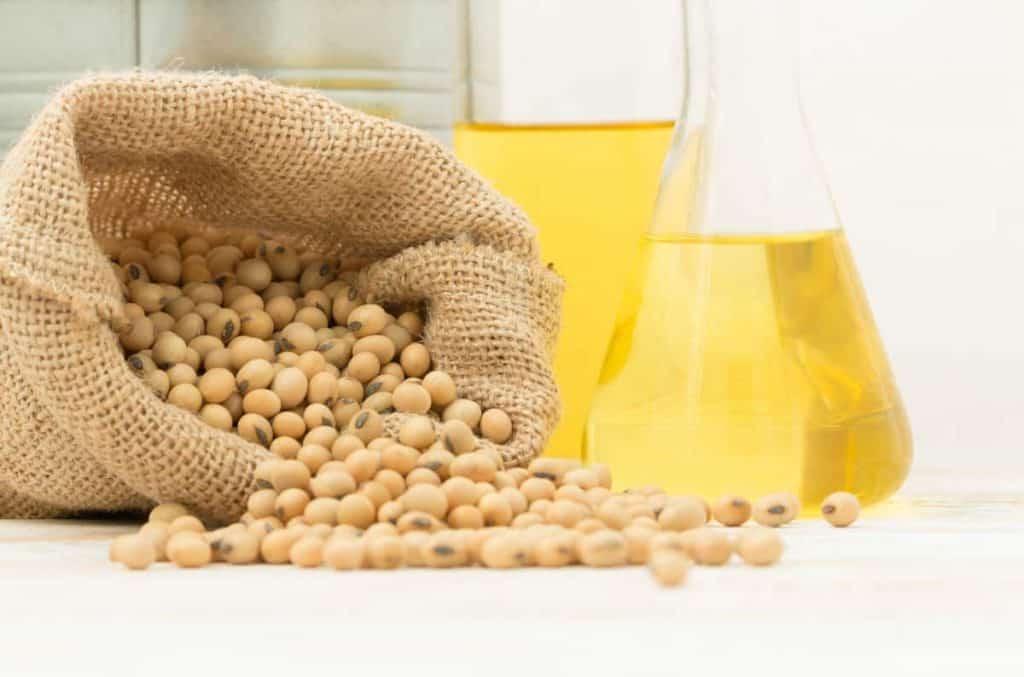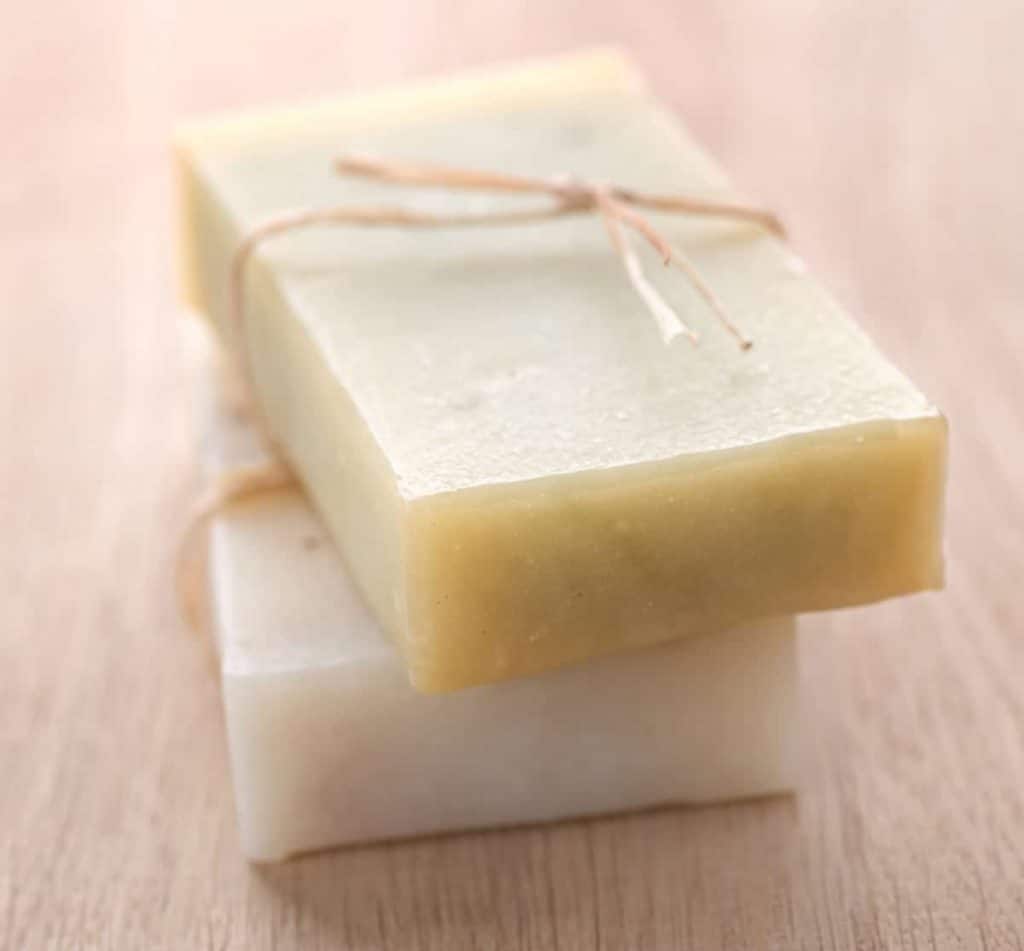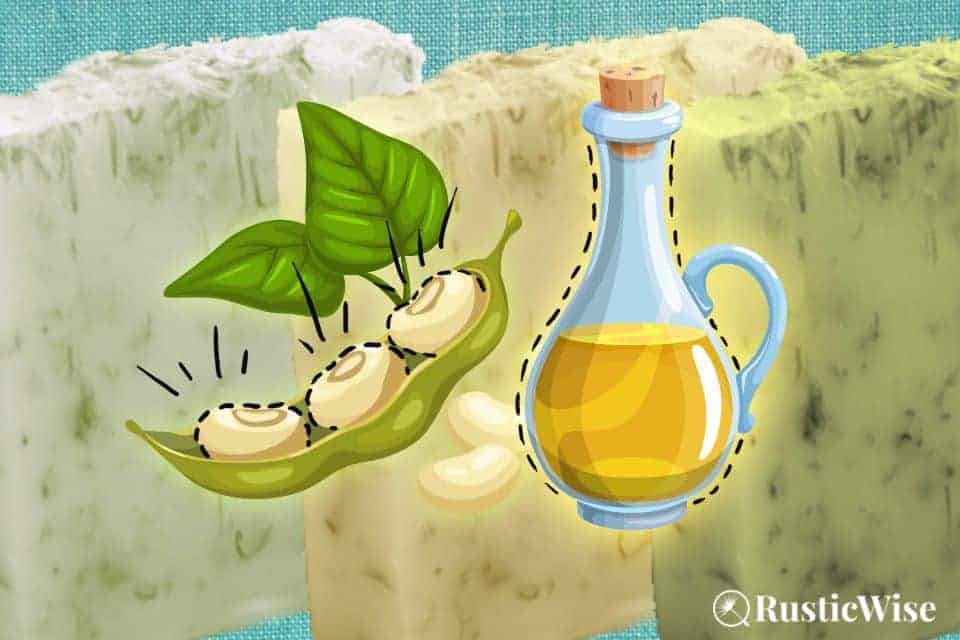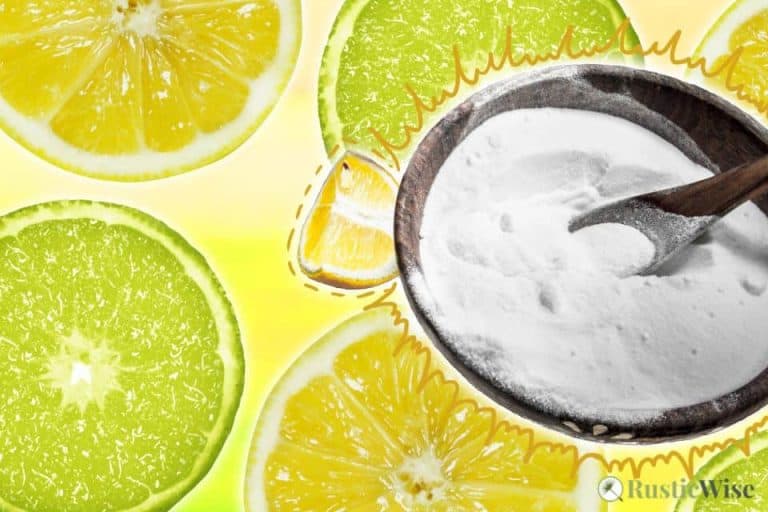Soybean Oil for Soap Making: Affordable and Easy To Find
RusticWise is supported by its readers. When you purchase through links on our site, we may earn an affiliate commission. As an Amazon Associate, we earn from qualifying purchases. Thank You!
If you’re looking for a budget-friendly and readily available vegetable oil for your next batch of soap, you might consider using soybean oil for soap making. Made from the oil of pressed soybean seeds, soy oil absorbs easily into skin and provides conditioning properties to bar soap.
It turns out that not every home soap maker is a fan of soybean oil, however.
Many soap makers have mixed feelings about soybean oil—some swear it makes great, affordable bars of soap, while others choose to pass on it. Read on to learn more about the properties of soybean oil in soap, and whether it’s right for you.
A closer look at soybean oil
The soybean plant (Glycine max) is a legume that belongs to the pea family. Soybeans are a vital global crop that is used as an affordable source of protein for millions of people and as a component of many household products.¹
Widely believed to have originated in China, the plant was introduced in the U.S. in 1804.¹ Today, the U.S. is the second largest producer of soybeans (coming second to Brazil).²
Manufacturers use soybean oil to make margarine, shortening, and plant-based cheese. The oil is also a key component of many paint and adhesive products, fertilizers, and as part of the backing used for linoleum flooring.
Soybean oil concerns
When it comes to soy oil, some people choose to steer clear of it. Why?
There are a few concerns with this legume, mainly that it is a genetically modified (GM) crop. In the U.S., the bulk of soybeans grown is GM to withstand the herbicide glyphosate.¹
This comes with its own environmental and health concerns. Some people avoid using any food products that are GM for these reasons.
If you are selling handmade soap, it’s good to note that some customers may be soy-averse. There are some non-GMO soybean oils available too. Look for non-GMO sources of soybean oil.
Other people may avoid soy products because of sensitive allergies.

Is soybean oil the same as vegetable oil?
Yes and no. You’ll find that many bottles labelled as “vegetable oil” on grocery store shelves comprise primarily of soybean oil. However, these bottles of vegetable oil typically contain a blend of several other vegetable oils too, including canola oil, corn, cottonseed, palm oil, peanut oil, safflower oil, or sunflower oil.
If you’re picking up a bottle of vegetable oil, make sure you carefully read the ingredients before you add it to your soap recipe.
When making batches of soap, it’s important to keep in mind that every oil has a unique fatty acids profile which affects the amount of lye required (SAP value) to turn it into soap. It’s very difficult to calculate the amount of sodium hydroxide or potassium hydroxide needed to saponify a vegetable oil blend.
Tip: Look for bottles labelled as 100 percent pure soybean oil and avoid blended vegetable oils when soap making.
Is soybean oil good for soap making?
Soybean oil is one of the most affordable oils for soap making. From a soap maker’s perspective, there are pros and cons of using soybean oil in soap.
The upsides are that it’s inexpensive, and easy to find at most grocery stores, or soap suppliers. When added to a cold process soap recipe, it ups the conditioning quotient and produces a stable, creamy lather. Soybean oil soap is good for dry skin and produces a mild soap.
When used by itself, it produces a very soft soap—pair it with harder oils for a better bar of soap.
The downsides are that regular soybean oil is high in linoleic fatty acids, which gives it a short shelf life (less than 1 year). When used in higher quantities, soybean oil can produce a bar of soap that’s sticky or slimy. Some soapers also experience dreaded orange spots (DOS), and/or soap rancidity.
Soybean oil is also used to make liquid soap. Or, some prefer to use soybean oil to make laundry soap.
Not everyone is a fan of soybean oil, however. There are also some soap makers that view soybean oil as a “cheaper” (not-in-a-good-way) oil that’s used as a filler or substitute for finer, more expensive oils.
On the flip side, there are some that love using soy oil. So, to each his/her own!
Tip: Since soy oil is prone to rancidity, keep the ratio to roughly less than 50 percent of oils used. As soybean oil produces a softer soap, it works best when paired with a harder oil such as coconut oil or palm kernel oil.
Types of soybean oil
Not all soybean oils are alike. In fact, soybean oil comes in regular liquid form, partially hydrogenated, and fully hydrogenated (solid form).
The fully hydrogenated form is sometimes called soy wax. Soy wax is a common ingredient used for candle making. Make sure that if you’re using soy wax to make soap, you’re using one that’s skin-safe.
The good news is that you can use all three types of soybean oil when making soap—just remember to run it through a lye calculator first as each has unique properties.
Both the partially hydrogenated and fully hydrogenated soybean oils have a longer shelf life as the amount of linolenic acid decreases. Fully hydrogenated soybean oil contains no linolenic acid.³
Let’s take a closer look at the properties of soybean oil. You’ll notice that fully hydrogenated soybean oil produces a harder bar of soap than unhydrogenated varieties.
Table: Properties of Soybean Oil for Soap Making
| Soybean Oil | Soybean Oil, Partially Hydrogenated (27.5%) | Soybean Oil, Fully Hydrogenated | |
|---|---|---|---|
| Hardness | 16 | 24 | 98 |
| Cleansing | 0 | 0 | 0 |
| Conditioning | 82 | 49 | 0 |
| Bubbly lather | 0 | 0 | 0 |
| Creamy lather | 16 | 24 | 98 |
| Lauric acid | 0 | 0 | 0 |
| Myristic acid | 0 | 0 | 0 |
| Palmitic | 11 | 9 | 11 |
| Stearic | 5 | 15 | 87 |
| Ricinoleic | 0 | 0 | 0 |
| Oleic | 24 | 41 | 0 |
| Linoleic | 50 (this causes soap to go rancid quickly) | 7 | 0 |
| Linolenic | 8 | 1 | 0 |
| NaOH SAP Value | 0.136 | 0.136 | 0.137 |
| KOH SAP Value | 0.191 | 0.191 | 0.192 |
Is soy soap good for skin?
While not exactly used for its skin nourishing properties, say like cocoa butter, soy oil isn’t exactly bad either.
As a lightweight oil, it absorbs easily into skin. It moisturizes and contains vitamin E. Vitamin E is good for keep skin inflammation in check and also acts as a barrier to lock in moisture.⁴
Soybean oil substitutes in soap making
When substituting any oil for another in a soap recipe, it’s important to look at the properties of each to find a suitable (and similar replacement).
If you want to skip the soy oil, a few similar oils you could try using instead are apricot kernel oil, avocado oil, hempseed oil, rice bran oil, sunflower oil, safflower oil, and sweet almond oil.
Always run your numbers through a soap calculator first to make sure everything looks okay!

Soybean oil soap recipe
Now, with all the talk about soybeans, let’s have a look at how you can make your own soy soap bar!
The following recipe is from the Alicia Grosso’s book, DIY Artisanal Soaps: Make Your Own Custom Handcrafted Soaps! ⁵
While this recipe uses slightly over 50 percent soybean oil, it’s balanced out by hard coconut oil, and brittle palm kernel oil for a conditioning bar of soap with stable lather and a decent amount of bubbles.
If you’re new to working with lye and making cold process soap, make sure you read up on lye safety first!
Supplies:
- Digital kitchen scale
- Thermometer (digital, infrared, or candy thermometer)
- Immersion blender (stick blender)
- Stainless steel saucepan for melting the solid oils
- A large bowl for measuring the liquid oils into
- Heat-safe jug for the lye solution
- Rubber spatula for stirring and scraping
- Loaf mold
- Safety gear (goggles and gloves)
Yield: 1 pound batch of soap
Ingredients
Lye solution:
- 2.4 ounces sodium hydroxide
- 6 ounces distilled water
Hard oils:
- 4 ounces coconut oil (76 degree)
- 4 ounces palm kernel oil
Liquid oils:
- 9 ounces soybean oil
- 1 tablespoon castor oil (superfat)
- Prepare the lye solution. Put on your safety gear! Measure the distilled water and add to heat-safe jug. Measure the sodium hydroxide and slowly add to water. Allow the lye mixture to cool.
- Measure and melt hard oils in a saucepan. Heat the hard oils in a non-reactive saucepan until melted, then measure and add liquid oils until well combined.
- Bring to trace. Once the lye mixture has cooled and is of similar temperature to the combined oils, carefully add the lye to the oils. Use an immersion blender (stick blender) to combine the soap batter until it thickens and turns opaque (reaches trace).
- Pour into mold. Pour the soap batter into a prepared mold.
- Set and cure. Allow the soap batter to completely cool and harden (at least 24 hours). If soap has hardened, unmold and cut into bars. If bars are too soft, allow it to set for several more days. Let the soap bars cure for 3 to 4 weeks in a well-ventilated room. You’ll get a longer lasting bar this way.
The takeaway: soybean oil for soap making
The oils in soap you use are a personal choice, one that depends on budget, personal preferences, and of course, the desired properties in your finished soap.
Soy oil is an affordable and readily available type of soft oil you can incorporate as a base oil for your next soap recipe. Just remember to balance it out with harder longer lasting oils such as coconut or palm kernel oil.
Related questions
Can you use soy soap if you have a soy allergy?
This really depends on your level of sensitivity to soy. According to Food Allergy Canada, “People who are allergic to soy may not need to avoid soy oil. Soy oils tend to be refined enough to remove all of the proteins that can trigger allergic reactions. However, if you have soy allergy, consult with your allergist…”⁶
Some people with severe soy allergies may experience an allergic reaction by using a soy-based soap. Test a small amount of soy oil soap on a patch of skin and wait for at least 24 hours to check for signs of a reaction.

References
- Britannica, Soybean plant, https://www.britannica.com/plant/soybean. Accessed November 2021.
- Statista, Leading soybean producing countries worldwide from 2012/13 to 2020/21, https://www.statista.com/statistics/263926/soybean-production-in-selected-countries-since-1980/. Accessed November 2021.
- Bakerpedia, Soybean Oil, https://bakerpedia.com/ingredients/soybean-oil/. Accessed November 2021.
- Link, Rachael (09 June 2020). “6 Benefits of Soybean Oil (and Some Potential Downsides)“, Healthline. Accessed November 2021.
- Grosso, Alicia (2016). DIY Artisanal Soaps: Make Your Own Custom Handcrafted Soaps! Adams Media. pp. 179-180. ISBN 978-1-4405-9408-3.
- Food Allergy Canada, Soy, https://foodallergycanada.ca/allergies/soy/. Accessed November 2021.

Author: Josh Tesolin
Josh is co-founder of RusticWise. When he’s not tinkering in the garden, or fixing something around the house, you can find him working on a vast array of random side projects.










